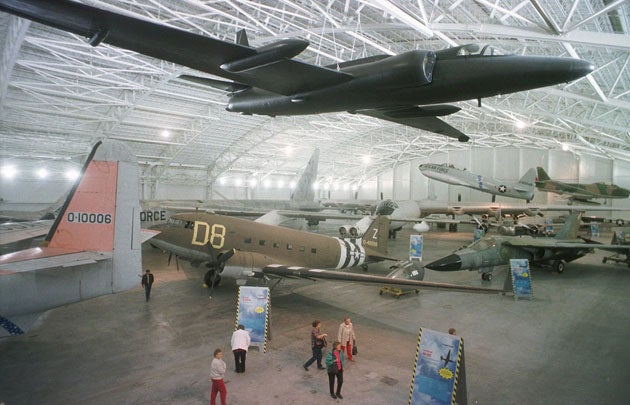Trail Of The Unexpected: Nebraska - giving the state its close-up
Plane speaking

Search for movies shot in Nebraska and it will leave you wondering how the Nebraska Film Office justifies its budget. Other than a documentary about a troubled family farm and some scenes of a paunchy Jack Nicholson in About Schmidt, it's pretty slim pickings – like the corn on that family farm actually...
But you can find Nebraska on film, you just need to know where to look (and, indeed, not insist on the film actually having been shot in Nebraska). In Stanley Kubrick's Dr Strangelove, George C Scott plays General "Buck" Turgidson, a character believed to be modelled on General Curtis LeMay.
The ultimate cold warrior, LeMay created the US Air Force's Strategic Air Command (SAC) at a base near Omaha, Nebraska, in the Fifties. Here, surrounded by corn, LeMay commanded a force of thousands of nuclear-armed bombers that were ready to obliterate the Soviet Union at a moment's notice. He famously advocated an American first strike on the Soviets using the logic: nuke them before they nuke you.
Today, Omaha is still the home of LeMay's Offutt Air Force Base, although SAC and the general are long gone. (George W Bush took shelter here in a bunker for a while on 9/11). The base's legacy is celebrated at one of Nebraska's major tourist attractions, the Strategic Air & Space Museum. In 1998 the collection moved from Omaha to Ashland, 30 miles south-west (well, within the lethal radius of a one megaton nuclear bomb) and conveniently right on Nebraska's transport spine, highway I-80.
The complex brims with Cold War weaponry, including a whole family of bombers including the B-1, B-17, B-29, B-47, B-52.
The eeriest exhibit is the EC-135C, a modified Boeing 707 that was part of Operation Looking Glass. From 1961 until 1990, one of these planes was always in the air, with a general who could simply push the button and command a nuclear strike on the Soviets, even if the rest of America was already glowing. The gift shop brims with themed merchandise including toys such as the Air Burst Mighty Missile (made by a Scottish company, a perfect present for little cold warriors) and iridescent orange men's boxers bearing the legend: "Remove before flight."
Who would expect the museum chronicling a planet-pulverising force to be located right along the I-80? But anything of interest along Nebraska's stretch of the main highway from New York to San Francisco has to be celebrated. Every year, many millions of motorists are lulled into a stupor by its 455 miles, arrowing across Nebraska's barely rolling terrain (including the longest stretch of straight road in the US, at 72 miles).
Those whizzing along I-80 non-stop are missing out on a piece of American heritage that is central to the nation's legacy. The concrete ribbon follows the way west first used by hundreds of thousands of settlers and later by the Union Pacific for the first transcontinental railroad.
Pause at Grand Island, a town of 43,000. This was the birthplace of Henry Fonda, who starred in another film about SAC run-amok, Fail Safe. Today the main attraction is the Stuhr Museum of the Prairie Pioneer, a surprisingly lively look at the 1800s.
Movie-makers have ignored Nebraska's role when the wagon trains rolled through on their way west. Few encountered the dramatic landscapes of Hollywood, rather, they puttered along Nebraska's Platte River, left a trail of digested beans and fended off attacks by Indians.
Yes, Indians: another film cliché denied Nebraska. This state was the location of many of the storied battles between settlers, the cavalry and Indians. At Kearney (pop. 31,000), the halfway point on I-80's transcontinental length, a pioneer attraction spans the highway. The Great Platte River Road Archway Monument portrays more of the pioneer fortitude depicted at the Stuhr while showing the causes of conflict like the buffalos (there's a recreated stampede).
Once covering the grassy plains of Nebraska – and feeding 15 Indian tribes, including the Cheyenne – the buffalo were exterminated in the 19th century, mostly for amusement and often from special trains on the transcontinental railroad. Again, movies about this era of America's past almost always have dramatic rocky outcrops, or a waterfall or some other photogenic and non-Nebraska-like feature.
Today, Nebraska doesn't need the studios to take its rightful place in movies. Anyone with a camcorder can make the state a star and by stopping at the right place and absorbing its past, you can see why it's ready for its close-up.
No airline flies direct from the UK to Nebraska. The usual approach to the state capital Omaha is by air, via Chicago.
Strategic Air & Space museum (001 402 944 3100; www.strategicairandspace.com).
Stuhr Museum of the Prairie Pioneer (001 308 385 5316; www.stuhrmuseum.org). Great Platte River Road Archway Monument, Kearney (001 308 237 1000; www.archway.org). www.visitnebraska.org
State lines: Nebraska
Population 1.7 million
Area almost 10 times the size of Wales
Capital Lincoln
Date in Union 1 March 1867
Flower Goldenrod
Motto "Equality before the law"
Nickname Cornhusker State
Subscribe to Independent Premium to bookmark this article
Want to bookmark your favourite articles and stories to read or reference later? Start your Independent Premium subscription today.

Join our commenting forum
Join thought-provoking conversations, follow other Independent readers and see their replies